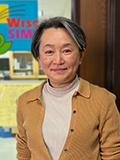Noriko Kita

Commendation
For outstanding achievements in the precise dating of chondrules in meteorites and the evolution of planetary materials in the protoplanetary disk
A list of five major papers
- Williams C. D., Sanborn M. E., Defouilloy C. E., Yin Q-Z., Kita N. T., Ebel D. S., Yamakawa A., Yamashita K. (2020) Chondrules reveal large-scale outward transport of inner Solar System materials in the protoplanetary disk. Proceedings of the National Academy of Sciences 117, 23426-23435.
- Ushikubo T., Kimura M., Kita N. T., and Valley J. W. (2012) Primordial oxygen isotope reservoirs of the solar nebula recorded in chondrules in Acfer 094 carbonaceous chondrite. Geochim. Cosmochim. Acta 90, 242-264.
- Kita NT, Nagahara H, Tachibana S, Tomomura S, Spicuzza MJ, Fournelle JH and Valley JW (2010). High precision SIMS oxygen three isotope study of chondrules in LL3 chondrites: Role of ambient gas during chondrule formation. Geochim. Cosmochim. Acta 74, 6610-6635.
- Kita N. T., Ushikubo T., Fu B., and Valley J. W. (2009) High Precision Sims Oxygen Isotope Analysis and the Effect of Sample Topography. Chemical Geology 264, 43-57.
- Kita, N.T., Nagahara, H., Togashi, S. and Morishita, Y. (2000) A short duration of chondrule formation in the solar nebula: evidence from 26Al in Semarkona ferromagnesian chondrules. Geochim. Cosmochim. Acta 64, 3913-3922.
Major achievements
Dr. Kita has been conducting high-precision isotope analysis of primordial meteorites, differentiated meteorites, asteroid and comet return samples, and interplanetary dust for many years, and has made significant contributions to the fields of meteorite science and planetary science. Dr. Kita’s research has greatly expanded our knowledge and understanding of early solar system materials and their formation processes, and her greatest research achievement is elucidating the age difference of heating events and the distribution of oxygen isotope ratios in protoplanetary disks based on high-precision oxygen isotope ratio analysis and Al-Mg isotope dating of chondrules and CAIs. She has also worked hard at the University of Wisconsin to develop and establish technology to meet the conflicting demands of high precision and high spatial resolution in isotope ratio analysis using SIMS. She is also dedicated to mentoring and training postdoctoral researchers, and has made an enormous contribution to education in this field.
[ ORCiD ]
Nominator
Tomoki Nakamura
Supporters
Takashi Mikouchi, Yuji Sano, Naoji Sugiura
